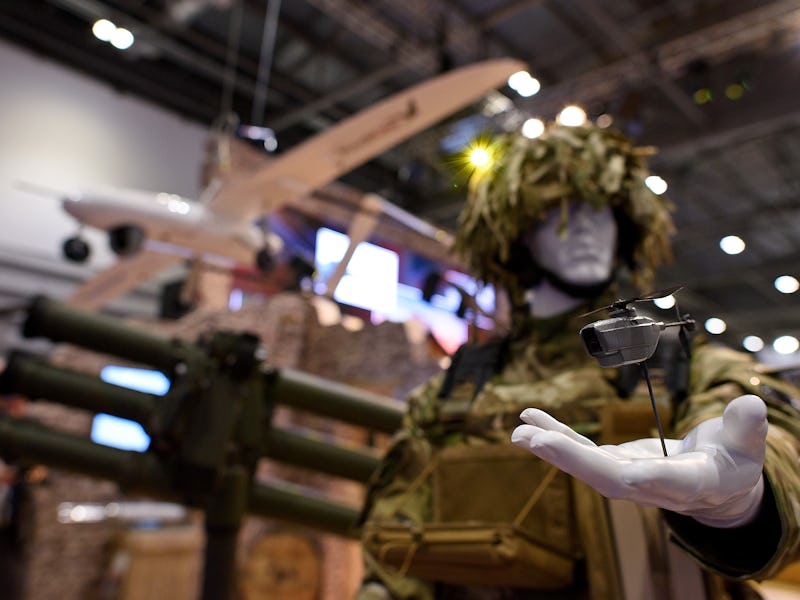The Military's Micro-Drones Aren't Armed. For Now.
Cheap, small drones, like the Cicada, could be the future of counterterrorism operations.

President Obama’s lasting foreign policy legacy will be the massive expansion of the semi-covert drone programs run by the CIA and the Pentagon. What are the ramifications of his administration’s use of drones, and what will the next decade of remote-controlled warfare look like?
A new report out this week suggests that, for now, drones aren’t changing the way countries go to war. Their greatest impacts instead have been on counterterrorism operations, such as those carried out by the U.S., Israel, and Pakistan. Drones also have the potential to change how authoritarian regimes crush internal dissent.
It’s an interesting read, and suggests that the next generation of drones could have even more profound effects on global armed conflicts. The report doesn’t touch on one especially troubling development in unmanned vehicle technology, though: the emergence of micro-drones.
There are a few different models of micro-drones in production right now. One is called the Cicada, which stands for Close-In Covert Autonomous Disposable Aircraft, and was deliberately named after the bug. A recent AFP article described it as a “paper airplane with a circuit board.” The same article said that they would be deployed by being dropped out of an airplane and gliding to the earth’s surface. In an experimental setting, an on-board GPS directed the Cicadas to inside 15 feet of its programmed destination after an 11-mile fall.
The so-called “micro air vehicle” fits in the palm of your hand, costs a thousand bucks (though that price could drop significantly), and is meant to be deployed in “swarms,” the U.S. military’s new favored phrase to describe the role that cheap, small drones will play in the future of warfare.
The tiny drones are coming: Here a stand host holds a QH micro quadcopter drone by Chinese manufacturer Lian Sheng at the 2015 CeBIT technology trade fair on March 16, 2015 in Hanover, Germany.
The idea is that the Cicadas will operate as small, remote listening posts that — if deployed in sufficient numbers — will be impossible for an enemy to clear from a town or secluded fields around an outpost. “You equip these with a microphone or a seismic detector, drop them on that road, and it will tell you ‘I heard a truck or a car travel along that road.’ You know how fast and which direction they’re traveling,” Aaron Kahn of the Naval Research Laboratory told AFP.
These robo-paper-airplanes could eventually be more than just advanced microphones and seismic sensors, though. As The Washington Post notes, the official description of Cicadas says the platform will be an “unmanned glider, nearly undetectable, that delivers payloads to precise waypoints.” The word “payload,” of course, connotes some sort of explosive. Will these cheap autonomous micro-drones be used as kamikaze swarms in the future?
One of the other prominent micro-drones in use is the Black Hornet, manufactured by Prox Dynamics. The British military began using Black Hornets in Afghanistan in 2012, according to the BBC, for surveillance purposes. The small helicopters weigh less than half a pound, and measure about four inches by one inch. They can’t go far, or fast — the range reportedly tops out at half a mile, and their top speed is 22 mph — but they can be piloted remotely or be given GPS coordinates and operate automatically. The Black Hornet is marketed as the first “commercially available Personal Reconnaissance System”, equipped with a lightweight camera that sends a video feed back to the operator, and is viewable on a tablet.
The upshot of all of this is that drone technology is progressing in all sorts of different directions. Some of them, like the Cicada and Black Hornet, are getting smaller. Some are capable of operating for longer periods, with more autonomy. The next generation of drones could have air-to-air capabilities, or sophisticated stealth and evasion technology, which no current UAVs have.
And what we know already, from the new report this week, is that drones are already changing the landscape of counterterrorism operations. They will also change the landscape for law enforcement and security services that want to crack down on dissent.
When drones can be given GPS coordinates, or a SIM card signal, or a biometric identifier, or any other of a number Big Data signatures, and simply let fly, can we really believe that governments won’t take advantage of that weapon? For now, the most pressing danger for the vast majority of civilians living in war zones is traditional weaponry, whether that’s Assad’s barrel bombs or the Pakistani fighter jets that have leveled villages in federally administered tribal areas in Pakistan. But the new generation of small, targeted killing machine might not be far away.